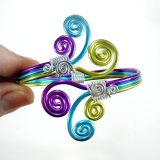Could yarn be used to create heat?
We know that wool is one of the best insulators of heat. In fact, it’s been keeping us warm for thousands of years. But researchers are now looking into slightly different thermodynamic uses of yarn, with the development of a thermo-electric yarn. But what does this mean exactly?
The Seebeck Effect
Scientists have been looking into what is called the ‘Seebeck Effect’ to help create sustainable energy. This is where materials can harness heat from the things around them. When this heat is used to harness an electric voltage, the materials used are called thermo-electric materials.
Unlike many other methods of garnering heat, using bismuth for thermo-electrics is silent, has no vibrations and is low in maintenance. However, a large stumbling block is that bismuth is brittle and inflexible, which limits its possible uses.
Uses of Thermo-Electric Yarn
Researchers are now looking into ways to make yarn thermo-electric, by weaving it with nanoribbons of bismuth. As yarn is flexible and non-brittle, it has a huge advantage over the way the thermo-electric materials have so far been used.
One possible use for this thermo-electric yarn is that it could be used to power a wearable device. This would mean no more pesky charging or low battery. Another key advantage of this technology is that it can be scaled easily, making it more affordable.
While we wait for science, we can keep on wearing homemade woolly jumpers just to keep us warm, and we’ll have to depend on batteries for our devices. If you’re thinking of starting a knitwear project, then begin with some needles and quality wool such as DK yarn, which is available from trusted retailers like https://www.woolcouturecompany.com/collections/dk-yarn.
In the future, such thermo-electric yarn could make it easier than ever to wear wearable technology. However, jumpers woven from thermo-electric materials are probably not something we’re going to be seeing in the high street anytime soon.
















